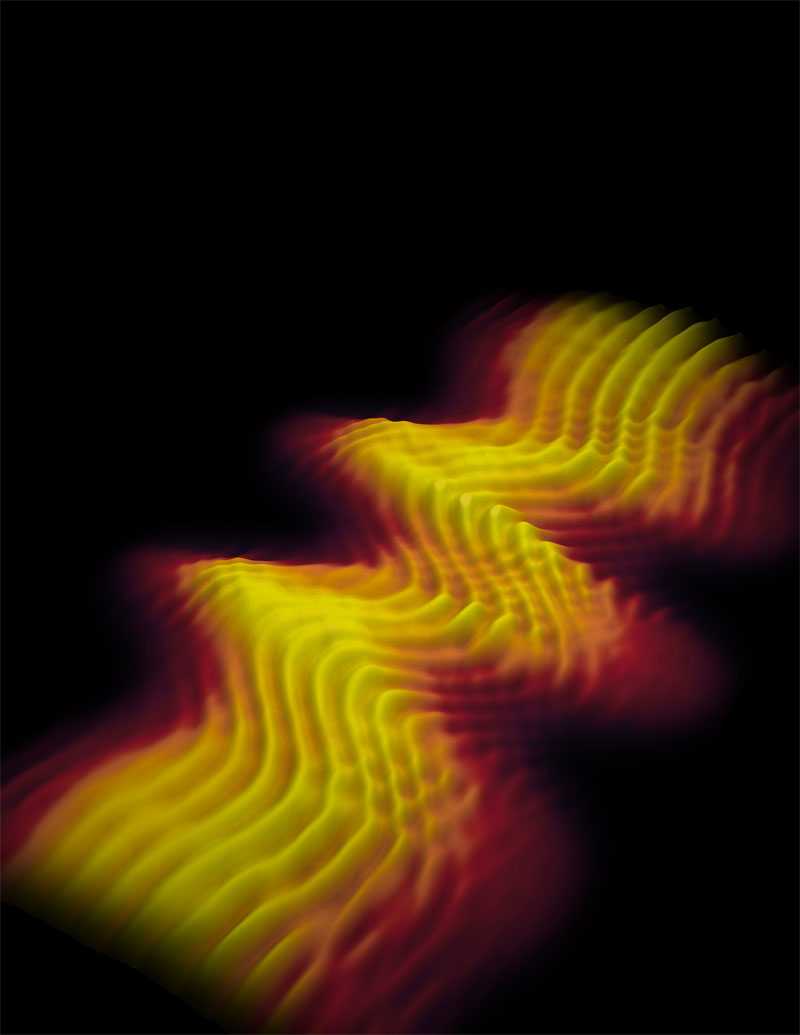Shaping Single Photons
You can squeeze it and stretch it and even chop it up, but a photon is still a photon, a particle of light. Physicists have been manipulating single photons for several years, but now a team has modulated the time profile of a photon. Using the same optical equipment that fashions ordinary light pulses, the team molded single photons into arbitrary shapes, such as a pair of square pulses, as they describe in the 5 September Physical Review Letters. This precise control could have uses in quantum cryptography and quantum memory storage.
When you detect a photon, you can say where, when, and with what frequency it arrived, but before the measurement, these parameters are undefined. The photon’s existence is embodied in a wave function, which gives the probability of measuring the photon at any time, place, and frequency. The wave function for a single photon is usually a “wave packet”–nearly zero everywhere except in a narrow range of space and time. But as long as you don’t detect the photon directly, you can manipulate its wave function into any complicated shape, in theory.
Manipulation of a wave packet is not new. If a light beam directed through a pair of slits is dim enough, then photons proceed one at a time, and the slits split the wave packet in two. These two pieces interfere to produce the classic double slit interference pattern of alternating regions of high and low photon probability. Researchers have also recently been able to filter a single photon, thereby narrowing the range of frequencies in the wave packet.
But changing the time dependence of a photon’s wave packet has been more difficult. You have to know when the photon is in the modulating device, and then you need time to change it. You can locate the particle by generating a pair of photons simultaneously and letting one of them “flag” the arrival of the other. But paired (or “entangled”) photons typically have wave packets that are one tenth of a picosecond long, which is too short for current technology, says Steve Harris of Stanford University in California. The situation changed earlier this year when Harris’s team generated an entangled photon wave packet nearly a microsecond long, using the recent techniques known as “slow light” and “electromagnetically induced transparency” [1].
They have now applied their technique to single photon modulation. First, they generated an entangled pair of photons with slightly different frequencies in a rubidium gas. The lower frequency photon traveled through the gas at near the traditional speed of light, while the higher frequency one moved at roughly 1/10,000 the speed of light, due to its interaction with the rubidium. Detection of the fast-moving photon signaled the arrival time of the slow-moving photon in their pulse-shaping device, called an electro-optic modulator. This piece of equipment, which was identical to models used in the telecommunications industry to shape multi-photon signals, could imprint an arbitrary shape on the stretched out wave packet [2].
It is not possible to directly measure a wave packet, so the researchers detected a large number of identical photons and plotted the probability of the photon appearing at the detector at each time over a 300-nanosecond period. In one of these plots, the team shows a single photon wave packet that has been shaped into two square pulses of 50-nanosecond length. They also generated wave packets with a Gaussian (bell-shaped) peak and an exponential shape (rapidly rising, then a sudden cut-off). Harris points out that single photons have in the past been generated in special cavities to have particular wave packet shapes, but an electro-optical modulator provides a much higher degree of control.
“I think this work is of both fundamental and practical significance,” says Mikhail Lukin of Harvard University. “It represents an important step toward ultimate control of single photons,” he says, and it could be part of future systems for encrypting information with photons. It could also simplify the task of storing a photon’s wave function in an atomic medium for a quantum computer memory, says Irina Novikova from the College of William and Mary in Williamsburg, Virginia.
–Michael Schirber
Michael Schirber is a Corresponding Editor for Physics Magazine based in Lyon, France.
References
- S. Du et al., “Subnatural Linewidth Biphotons with Controllable Temporal Length,” Phys. Rev. Lett. 100, 183603 (2008)
- The electro-optic modulator used in these experiments works by splitting incoming light into two parallel paths, each containing a transparent crystal that slows light in proportion to an applied electric field. The field varies in time as specified by the experimenter. When the two paths recombine, their relative staggering will cause them to interfere in a controlled way that produces the desired shape
More Information
More on quantum cryptography with photons: K. Inoue, E. Waks, and Y. Yamamoto, “Differential Phase Shift Quantum Key Distribution,” Phys. Rev. Lett. 89, 037902 (2002)





